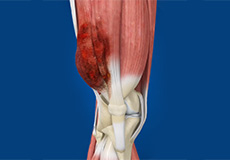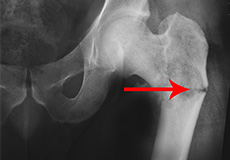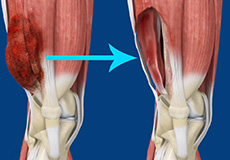
What is Orthopedic Oncology?
Orthopedic Oncology is a medical specialty that offers exceptional care to individuals diagnosed with tumors and tumor-like medical conditions of the bone and soft tissue, including bone metastases, sarcomas, benign and cancerous tumors of the bone or soft tissue, and pathologic fractures.
An orthopedic oncologist is a highly-trained doctor who specializes in the diagnoses and treatment of primary, benign, and malignant tumors of the bones.
Orthopedic Oncology involves working closely with general surgical oncologists, medical oncologists, radiation oncologists, radiologists, pathologists, and plastic surgeons to deliver a coordinated and multidisciplinary approach to care for each individual.
Medical Conditions Requiring the Intervention of Orthopedic Oncology
One of the main goals of the Orthopedic Oncology specialty is to deliver state-of-the-art treatment for musculoskeletal tumors. Some of the diseases that require Orthopedic Oncology intervention include:
- Ewing's sarcoma: This is a rare cancer that either begins in the soft tissues surrounding the bones or directly in the bones of children and young adults. The long bones of the body, such as the arms and legs, and the pelvis are commonly affected. Pain and swelling are the most common symptoms.
- Chondroblastoma: This is a rare benign cartilaginous neoplasm that characteristically occurs in the epiphysis of a long bone in young patients. Despite being rare, they are one of the most frequently encountered benign epiphyseal neoplasms in skeletally immature patients.
- Chondrosarcoma: This condition may occur in the pelvis, thigh areas, and shoulders of older adults. It forms in the subchondral tissue, which is the tough connective tissue between your bones. This is the second most common primary cancer involving the bones.
- Chordoma: This is a rare type of cancerous tumor that can occur anywhere along the spine, from the base of the skull to the tailbone. Chordomas grow slowly, gradually extending into the bone and soft tissue around them. They often recur after treatment, and in about 40 percent of cases, the cancer metastasizes (spreads) to other areas of the body, such as the lungs.
- Multiple myelomas: This is the most common type of bone cancer. This occurs when cancer cells grow in the bone marrow and cause tumors in several bones. Multiple myelomas typically display the most activity in bone marrow, which includes the marrow in the spine, pelvic bones, ribs, shoulders, and hips. Multiple myelomas usually affect older adults.
- Osteosarcoma: Osteosarcoma, or osteogenic sarcoma, generally affects children and adolescents, but it can also occur in adults. It has a tendency to originate at the tips of the long bones in the arms and legs. Osteosarcoma may also start in the hips, shoulders, or other locations. It affects the hard tissue that provides the outer layer of your bones.
- Giant cell tumor: This is a rare, aggressive non-cancerous tumor that generally occurs in adults between ages 20 and 40 when skeletal bone growth is complete. This usually develops near a joint at the end of the bone. The location of the tumor is often in the knee, but can also involve the bones of the arms and the legs. It can also affect the flat bones, such as the breastbone or pelvis.
- Lymphoma of bone: This condition affects adults usually in their 40s and 50s and may occur in any bone. The tumor involves small round cells, often with a mixture of reticulum cells, lymphocytes, and lymphoblasts. Pain and swelling are the usual symptoms of lymphoma of bone. Pathologic fracture is common in this condition.
- Adamantinoma: This is a rare type of malignant bone tumor affecting less than 1% of individuals and most often develops in the tibia. It mostly occurs in adolescents and people who are in their 20s but can occur at any age. Adamantinoma is slow-growing and often manifests with pain and palpable fullness.
- Soft tissue sarcomas: These are rare type of cancers that begin in the tissues that connect, support, and surround other body structures. This includes muscle, fat, blood vessels, nerves, tendons and the lining of your joints. Surgical removal is the most common treatment, although radiation and chemotherapy may also be recommended.
Diagnosis of Musculoskeletal Tumors
In order to diagnose malignant musculoskeletal tumors, your orthopedic oncologist may order the following diagnostic tests:
- X-rays
- CT scan
- MRI scan
- Positron emission tomography (PET) scan
- Blood test
- Bone scan, which checks the condition of the bones
- Bone biopsy, which analyzes a small sample of tissue to diagnose cancer
Treatment for Musculoskeletal Tumors
There are 3 approaches to treat musculoskeletal tumors including surgery, radiation therapy, and chemotherapy.
Surgery: This approach aims to remove the tumor and some of the healthy bone tissue that surrounds it. If some of the cancer is left behind, it may continue to grow and eventually spread.
Limb-sparing surgery, also known as limb salvage surgery, means that surgical intervention occurs without having to amputate the limb. The surgeon may take some bone from another part of the body to replace lost bone, or an artificial bone may be fitted. In some cases, however, amputation of a limb may be necessary.
Some of the common surgeries include:
- Radical resection of soft tissue sarcoma in the extremity: This procedure involves removal of the tumor with a cuff of normal tissue which ensures complete removal of the tumor. This requires the removal of an entire muscle group, the lining of the bone and ligaments or tendons. Expertise in limb salvage promotes the best functional results for the patient. Resection is performed in a manner that maximizes both oncologic and functional outcome.
- Internal hemipelvectomy: This is a technically demanding surgical procedure performed for the treatment of pelvic tumors. During this procedure, a section of the pelvis is removed while preserving blood supply and nerve function to the limb.
- En bloc spinal resection: This is a complex surgery designed to remove tumors within the bones of the spine. The objective of an en bloc resection is to accomplish a total resection of the tumor in one piece, reducing the risk of tumor spread during removal. Multiple vertebrae may be removed. Once the tumor has been removed, spine reconstruction is performed to maintain spine stability and maximize function.
- Expandable endoprosthesis: Removal of bone tumors in children usually results in the removal of one or more of the bone's growth plates. This can lead to a significant shortening of the limb when compared with the unaffected limb that continues to grow normally. Expandable prostheses can be used to non-invasively lengthen the limb. This is achieved by lengthening the prosthesis in small increments over time. The lengthening process is performed during follow up clinic visits and is done without further surgery or anesthesia.
- Rotationplasty: This is a surgical procedure that can be used to treat malignant bone tumors, such as osteosarcoma or Ewing sarcoma, that occur near a child’s knee. The bottom of the femur, the knee, and the upper tibia are surgically removed. The lower leg is then rotated 180 degrees and then attached to the femur. This unusual procedure preserves the lower leg, attaches it to the thighbone, then uses the ankle as a knee joint.
- Computer navigation: Computer-assisted navigation surgery is specialized surgery utilizing complex 3D imaging in real-time to help the surgeon localize the tumor and the surrounding critical structures. This helps the surgeon navigate complex anatomy often distorted by the tumor. This surgery improves the accuracy, precision, and safety of the procedure and is commonly used in spine, pelvic, and sacral tumor resections.
Radiation Therapy: Radiotherapy is commonly used in the treatment of many cancer types. It involves the use of high-energy X-rays or particles to destroy cancer cells. Radiotherapy works by damaging the DNA inside the tumor cells and preventing them from reproducing.
Radiotherapy can be used to:
- Cure the patient by completely destroying the tumor.
- Relieve pain in more advanced cancers.
- Shrink the tumor, making it easier to then surgically remove it.
- Eliminate the cancer cells that remained behind after surgery.
Combination therapy is radiotherapy combined with another type of therapy. This may be more effective in some cases.
Chemoradiation, or radiotherapy combined with chemotherapy, may also be used.
Chemotherapy: Chemotherapy involves the use of chemicals to treat disease. More specifically, it refers to the destruction of cancer cells. The possible objectives of chemotherapy include:
- Total remission: Chemotherapy aims to cure the patient. In some cases, chemotherapy alone can get rid of cancer completely.
- Combination therapy: Chemotherapy can help other therapies, such as radiotherapy or surgery, produce better results.
- Delay or prevent recurrence: Chemotherapy, when used to prevent the return of cancer, is most often used after a tumor has been removed surgically.
- Slow down cancer progression: Chemotherapy can slow down the advancement of cancer.
Chemotherapy may also help to relieve symptoms and is more frequently used in patients with advanced cancer.

Cancer
Cancer is the uncontrolled division of abnormal cells. Cancer may begin anywhere in the body particularly in the skin, internal tissues or organs. A tumor is a mass of abnormal cells. Tumors are of two types: benign tumors and malignant Tumors. Benign tumors remain localized and do not spread to neighboring tissues.

Malignant Bone and Soft Tissue Tumors
Malignant bone and soft tissue tumors, also known as sarcomas, are cancerous growths which start developing in the bones or soft tissues such as tendons, muscles, fat, nerves, and blood vessels. There are different types of sarcomas and treatments vary depending on the location, severity, and type of the tumors.

Musculoskeletal Tumors
Musculoskeletal tumors are masses or lumps of tissue that develop in or spread to the musculoskeletal system as a result of abnormal and uncontrollable cell division. The musculoskeletal system includes the bones, joints, ligaments, muscles, and nerves.

Fractures in Cancer Patients
A fracture is a painful condition where there is a break in one or more bones. Certain types of cancer have been connected with an increased risk of fractures. A high-risk group regarding fractures includes cancers that primarily affect the bones such as primary bone cancer, lung cancer, multiple myeloma, prostate cancer, cancer of the liver, gall bladder, and pancreas, breast cancer, metastases to the bone, and metastases to organs other than bone.

Bone Tumor Ablation
Ablation is a treatment to destroy cancerous cells or tumors. Bone tumor ablation is a minimally invasive surgical technique that employs heat or cold energy to treat bone tumors without traditional surgery. The technique uses image guidance such as ultrasound, magnetic resonance imaging (MRI), or computed tomography (CT) scan to pass a needle or probe through the skin into the bone tumor to destroy the tumor cells instead of surgically removing the tumor.

Chemotherapy
Chemotherapy is a treatment that involves the use of medication to destroy cancer cells. It is used as a part of the breast cancer treatment plan. This procedure may be given prior to surgery (neoadjuvant chemotherapy) to reduce the size of large tumors so that a less extensive surgery can be performed to completely remove the tumor, or after surgery (adjuvant chemotherapy) to kill any stray cancer cells that may remain even after surgery, preventing the tumor from recurring.

Soft Tissue Sarcoma Resection
A sarcoma is a rare type of malignant tumor originating from the connective tissue in the body.It can develop in both the hard and soft tissues. Soft tissue sarcomas may develop in the muscles, fat, nerves, blood vessels, tendons, and other tissues around the joints and the deep tissues of the skin. Soft tissue sarcoma resection is a procedure to surgically remove the soft tissues affected by the sarcoma.





